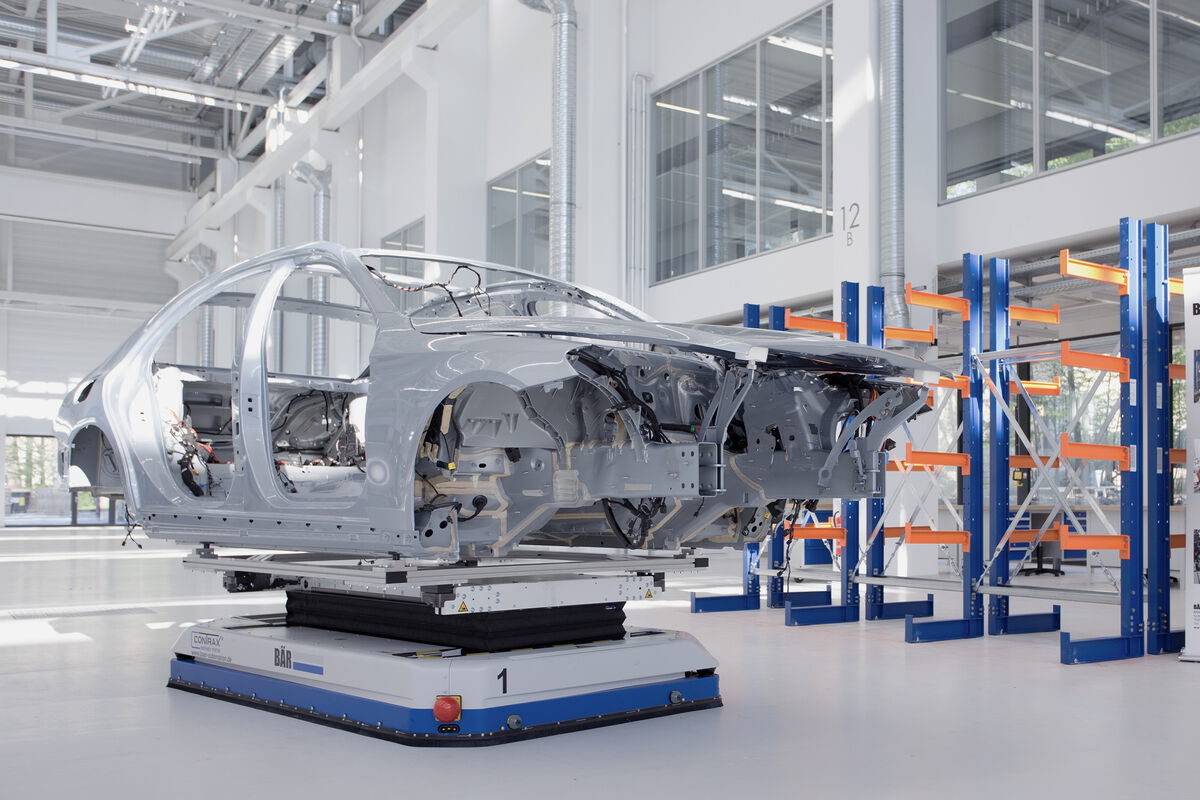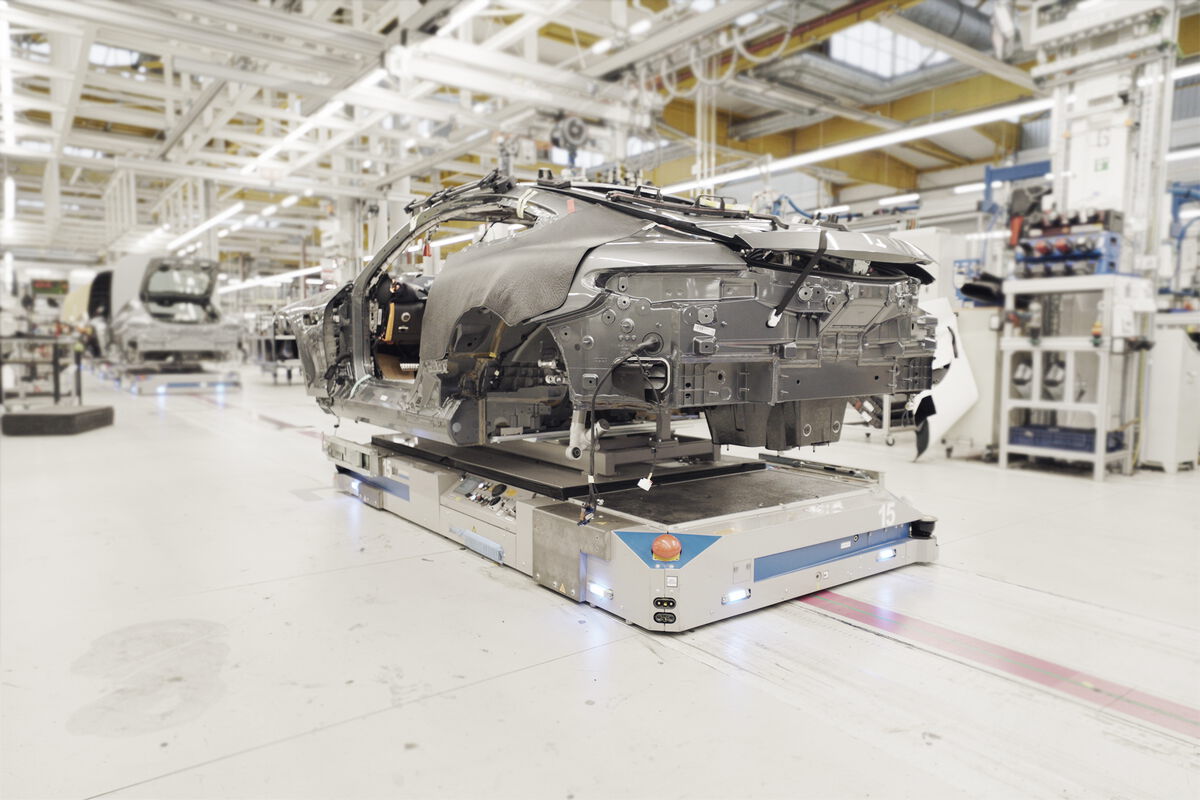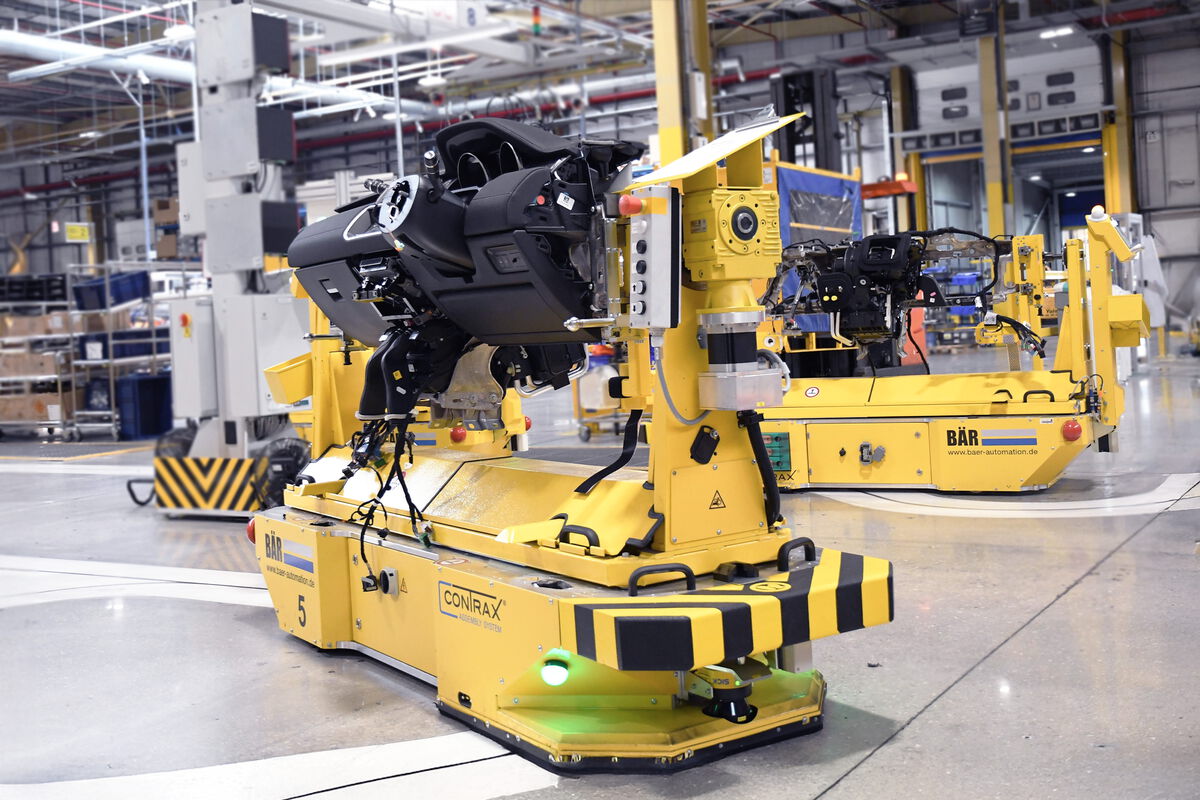AGV vs. AMR
What is the difference between automated guided vehicles and autonomous mobile robots?
Automated guided vehicles, or AGVs for short, have become an indispensable part of modern production and logistics processes. As part of an AGV system—an automated guided vehicle system—these floor- and track-bound conveyors enable the efficient transport of goods and merchandise. However, developments in Industry 4.0 are also bringing about significant changes in this area. The intelligent networking of machines and processes is intended to make processes more individualized and flexible in the long term, among other things through autonomous mobile robots (AMR). But what exactly is the difference between AGVs and AMRs? We will explain this in more detail below.
The differences between AGVs and AMRs
Both vehicles are floor-bound conveyors used to optimize intralogistics and production processes. So, what is the difference between an AGV and an AMR? Strictly speaking, there is not just one difference, but several differences between the two systems, which result from their navigation and the autonomy this entails. This leads to further differences in terms of the fields of application, flexibility and scalability, costs, safety precautions, and reliability of AGVs and AMRs.
Navigation – fixed guidance vs. dynamic routes
The biggest difference between the two types of transport vehicles lies in their guidance systems. While AGVs transport goods and merchandise along fixed tracks or routes, AMRs are autonomous in their driving mode. Although AMRs currently still travel along fixed routes, these are far more dynamic than those used by AGVs. The vehicles in an automated guided vehicle system, i.e., AGVs, are track-bound. They require fixed markings such as magnetic tapes, QR codes, or colored lines and reflectors to enable them to locate themselves. This makes planning the route network very complex and often requires major modifications to the operation. In addition, subsequent changes to the route network require further complex modifications.
An AMR, on the other hand, can respond more easily to a changing environment. While an AGV stops when it encounters an obstacle, an AMR can drive around it. However, like any system, autonomous mobile robots also need (traffic) rules. And contrary to the simplified representation that AMRs are robots that move freely using their own intelligence, AMRs also have fixed routes, albeit not track-bound ones. Similar to a taxi driver who knows different routes to a destination and always chooses the best one to save time, AMRs also always choose the best route to reach their specified destination. Since routes can vary dynamically, autonomous mobile robots require far more sensors than track-bound vehicles. In return, they are even easier to integrate into existing processes, as no additional infrastructure is required in the form of fixed markings.

Comparison of mobile robot applications
AGVs and AMRs can both be understood as subcategories of mobile robots.
While they share mobility as a common feature, they differ significantly in several respects, including their areas of application. While the use of AGVs requires extensive changes to expand production space or redesign existing operations, AMRs only require software adjustments. This means that AMRs can be used in a wide variety of applications, while AGVs are limited to one application after commissioning.

Flexibility and scalability
Due to the relatively simple adaptation of an AMR to new or changed tasks and environments, they enable greater flexibility and scaling of processes. To make the adjustment, all you need to do is change the map in the AMR's intuitive software to match your new production layout. However, how scalable an AMR fleet is depends on the intended use and is not linear.
In most cases, expanding the vehicle fleet requires little effort, up to the point where the vehicles block each other and controlling the flow of traffic becomes more complex. However, this point is not reached as quickly with AMRs as with AGVs. One reason for this is that an AMR can change its route depending on the situation by recalculating it using the control system, which means that blockages do not occur as quickly.
Safety – greater danger due to more autonomy?
AGVs have been an integral part of many transport processes in modern industry for many years. State-of-the-art laser sensors make the use of driverless transport vehicles very safe. The entire setup of the transport route is based on various safety regulations. But what about an AMR that simply avoids obstacles? Doesn't that increase the risk of accidents? That is not the case, because AMRs also work with highly complex laser technology.
There is therefore no risk of an AMR colliding with an obstacle when it avoids another one. However, this autonomy significantly increases the demands on the laser scanners, although the additional financial outlay for adapting the hardware as part of the safety measures is low. This is because the lasers used for navigation can often also be used as safety scanners.


Less reliability with more autonomy?
The use of automated guided vehicles has long been a way to optimize internal processes efficiently and reliably. AGVs are punctual and predictable, waiting times can be reduced, and transport damage and incorrect deliveries are significantly reduced through their use. Mislocalizations are also rare, and downtime is almost always due to an obstacle in the environment.
In contrast, AMRs are much more prone to errors, and their autonomy also makes problems more complex than with AGVs. The reliability of an AMR is therefore lower, but it does not decrease linearly with autonomy; rather, it depends in particular on the complexity of the AMR and the quality of its manufacture.
Price – high acquisition costs vs. costly adjustments
It is not surprising that autonomous mobile robots are significantly more expensive than automated guided vehicles due to their more complex sensor setups and software solutions. However, several factors must be taken into account when comparing the actual costs of both transport vehicles. Although the acquisition costs for an AMR fleet are very high, they do not usually require the costly infrastructure modifications that are often unavoidable with AGVs.
Subsequent adjustments to the environment can also be very costly and can be avoided with AMRs. In addition, more flexible fleets often require fewer vehicles. Whether the high acquisition costs of an AMR fleet are worthwhile compared to a lower product price plus potentially costly adjustments for an AGV fleet ultimately depends on the specific area of application and cannot be answered in general terms.
AGV vs. AMR – which is better?
Although AMRs offer many advantages and enable greater customization and flexibility in production processes in the long term, they are not always the right choice. If you need robust transport vehicles for fixed and often long distances, an AGV is often the better option. AGVs are less expensive to purchase, less prone to errors than AMRs, and perform their tasks precisely and reliably. In practice, many processes are still not very dynamic and hardly change over long periods of time. Investing in a highly flexible system without using it to its full potential would not be particularly economical.
Whether you invest in an AMR or AGV fleet depends on your goals and processes. Our comprehensive knowledge in the field of automation helps us to provide you with expert and efficient advice on which system you can use to optimize your processes quickly, efficiently, and economically in the long term.
Are there actually AGV robots?
There are automated guided vehicles (AGVs), there are autonomous mobile robots (AMRs), and there are AGVs with integrated robots that are used for mobile assembly systems, among other things. However, AGV robots do not exist. AGVs and AMRs can both be summarized under the term mobile robots, but the terms Automated Guided Vehicle (AGV) and Autonomous Mobile Robot (AMR) are opposites and are defined by their differences.
AGVs with integrated robots as part of modern assembly systems
As experts in automation technology, with a focus on automated guided vehicles and robot-assisted assembly systems, it makes sense to combine these two core competencies. AGVs with integrated standard robots from Bär Automation enable you to optimize your production even more efficiently and in a more targeted manner. The combination of AGVs and a wide variety of robot types for robot-assisted material and tool handling enables individualized process optimization while simultaneously reducing costs in the long term. To ensure that you remain competitive in the future, we use innovative approaches to create powerful, modern assembly systems.
Efficient assembly systems thanks to AGVs as mobile assembly stations
We can integrate various AGVs with integrated robots into your assembly systems, precisely tailored to the respective area of application. We implement both the electrical and mechanical integration of various robots, e.g., sensitive robots and lightweight robots, 6-axis robots, loading gantries, or pallet handling. The flexibility of robots as part of AGVs is particularly valuable in dynamic assembly processes. This is because the highly complex assembly systems used in modern manufacturing must be extremely precise and powerful, yet also scalable and flexible.
To achieve this, our assembly systems have a modular design. The individual stations make the entire system more flexible and allow changes in the production process to be implemented efficiently. Depending on requirements, the systems can be fully automated or, especially in complex systems, only partially automated. In this case, there are tasks that are performed by humans rather than machines. To ensure the internal process changeover between robot-assisted handling of workpieces and handling by humans is safe, the prescribed safety principles for human-robot collaboration must be observed.

Combining functionality and innovation
With robots mounted on AGVs, we can implement innovative assembly systems in a functional way. This is because they enable us to design our modular assembly systems even more flexibly. Driverless transport vehicles travel along fixed tracks to transport assembly robots to the respective workpiece for processing. We use not only innovative and modern technology, but also innovative approaches and unconventional ideas to combine functionality with efficiency and precision. Like all our systems, our AGVs with integrated robots are highly customized and tailored to your needs. Our experienced experts at BÄR Automation will be happy to advise you in detail on the possibilities for integrating AGVs and robots into your manufacturing or logistics processes.








